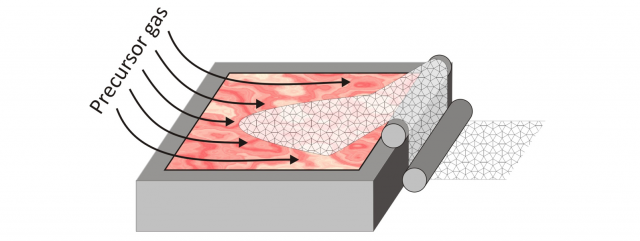Synthesis of 2D-Materials on Liquid Metal Catalysts
Two-dimensional materials (2DMs) such as graphene, hexagonal boron nitride, silicene and others, are currently amongst the most intensively studied classes of materials that hold great promise for future applications in many technological areas. However, the main hurdle against practical utilization of 2DMs is the lack of effective mass production techniques to satisfy the growing qualitative and quantitative demands for scientific and technological applications.
The current state-of-the-art synthesis method of 2DMs involves the dissociative adsorption of gas-phase precursors on a solid catalyst. This process is slow by nature, inefficient, and environmentally unfriendly. Our analysis and recent experimental evidence suggest that by using liquid metal catalysts (LMCats) instead, one can bypass multiple of these hurdles at once. This technique bears the prospect of continuous 2DM production with unprecedented quality and production speed.
Fig 1: Schematic of batch 2DM production using chemical vapor deposition onto a solid catalyst substrate, e.g. graphene growth on a solid copper catalyst.
Fig. 2: Schematic of continuous 2DM production using LMCats by direct separation of the 2DM from the LMCat, e.g. continuous graphene growth on a molten copper catalyst.
The aim of the LMCat project is to develop an instrumentation/methodology capable of studying the ongoing chemical reactions on the molten catalyst, with the goal to open two new lines of research, namely 1) in situ investigations on the catalytic activity of LMCats in general, and 2) unravel the growth mechanisms of 2DMs on LMCat surfaces in specific. This knowledge would be key for establishing the first efficient mass production method for 2DMs based on the proposed LMCat technology. This European project is initiated and coordinated by Leiden University in collaboration with LPM B.V., ESRF, CEA-INAC, U. Patras, and T.U. Munich.
- Direct separation of 2DMs from the LMCat, hence avoiding additional steps for separation of 2DMs from solid substrates. This can improve the production speed significantly, while reducing the process costs and waste.
- Continuous production of single-domain 2DMs with virtually unlimited length, in contrast to the batch production scheme using solid catalysts, in which the produced 2DM size is limited to the substrate size.
- Higher 2DM quality, as the liquid surface is extremely smooth, isotropic, homogeneous, and mobile. This allows for enhanced defect healing, and avoids the formation of domain boundaries in the 2DM.
- Higher 2DM growth speed due to the enhanced mass transport on the liquid surface.
- Lower production costs and higher environment friendliness, as the liquid catalyst is continuously reused. For a solid substrate, in each batch the precious catalyst should be chemically etched, leading to considerable loss of process time, materials, and energy, and the formation of significant amounts of chemical waste.
Effective mass production of high quality 2DMs can open up the possibility of exploiting the unique properties of these materials on an industrial scale and in everyday devices.


